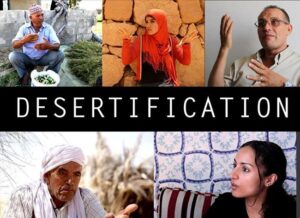The film ‘A Siege of Salt and Sand’ has many connections to the Cammett, Diwan, Richards, and Waterbury reading; both works specifically climate change, water scarcity, droughts, and the overall arid climate of the region. While the film focuses specifically on Southern Tunisia, both sources highlight these increasingly difficult environmental conditions that are constraining agricultural production as well as, daily human life. The film began with an introduction to the late 2010 democratic revolution toppling the Ben Ali dictatorship where protesters demanded an end to repression, corruption, and constitutional protections for political diversity, gender parity, the poor, and even the environment. However, after the revolution, few discussed climate change and even fewer admitted there were serious issues.
The film depicts the issues of parasites (leishmaniasis, the sand fly), the loss of palm trees, growing salt flats, an accelerated rising of sea level, the lack of rain affecting agricultural production, desertification, etc; many of which the reading fails to discuss. Instead, the reading heavily focuses on water and food security. Cammett et al. discuss how many countries save water by cutting back on irrigated agriculture; the problem is the majority of people in Southern Tunisia are farmers who have none or barely any access to water in general (Cammett et al. 199). In the film, many of the interviewees and the imagery itself demonstrate how many farmers are abandoning their lands and migrating to cities due to the lack of water, especially the governmental support to provide water, and the growing desertification of the already dry and arid land. The interviewees argued that the solution to the lack of water and growing desertification are wells and building sand walls, both also creating jobs for young people and provide water so the whole region can prosper; however, as Cammett et al. discuss, many government water management systems suffer from lack of funds (Cammett et al. 218).

Source: “EarthDay Event Explores Climate Pressure in North Africa and the Middle East // ‘a Siege of Salt and Sand’ Film Screening | Bonnections.de” 2017
Overall, I fairly enjoyed watching the film, specifically hearing interviews and personal narratives from region and subject matter experts such as political scientists, Marine ecologist, and presidents of environmental organizations, as well as ordinary people such as mothers, fishermen, farmers, and teachers and how it affects their culture and daily lives. I also really liked the use of both Arabic with English subtitles as well as English speakers; the Arabic allowing the reader to experience the native and authentic answers from people living in the region. However, while it was nice to hear from many different perspectives, it became quite repetitive to hear the same issues again and again, without any really grounded data and only personal perspectives.
Sources:
“A Siege of Salt and Sand”. Directed by Sam McNeil, produced by Sam McNeil and Radhouane Addala, 2014.
Cammett, Melani. A Political Economy of the Middle East. Available from: MBS Direct, (4th Edition). Taylor & Francis, 2018.
“EarthDay Event Explores Climate Pressure in North Africa and the Middle East // ‘a Siege of Salt and Sand’ Film Screening | Bonnections.de.” 2017. April 12, 2017. https://www.bonnections.de/en/2017/04/12/earthday-event-explores-climate-pressure-in-north-africa-and-the-middle-east-a-siege-of-salt-and-sand-film-screening/.

Leave a Reply